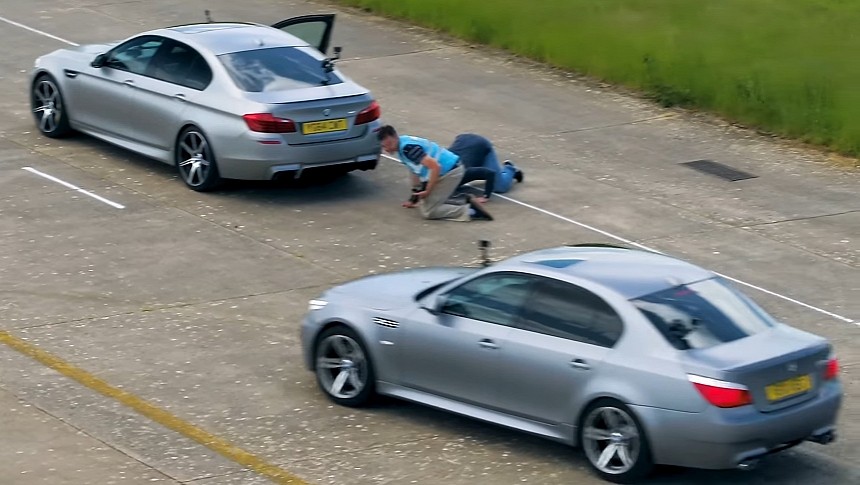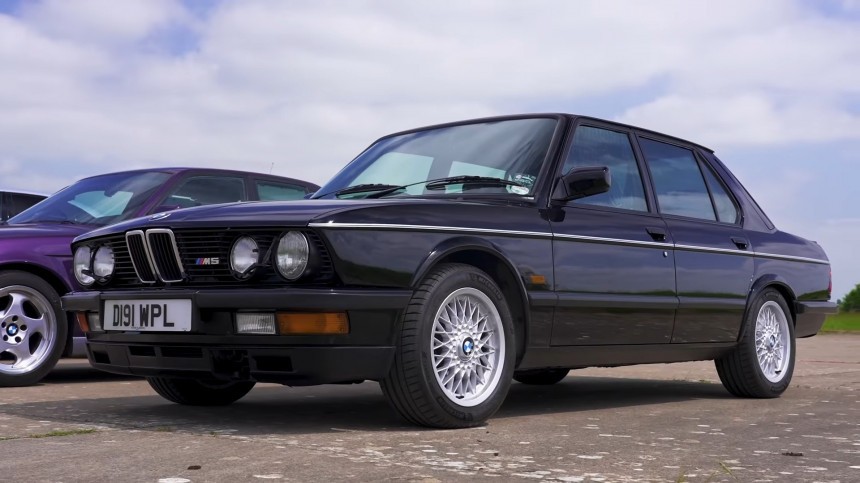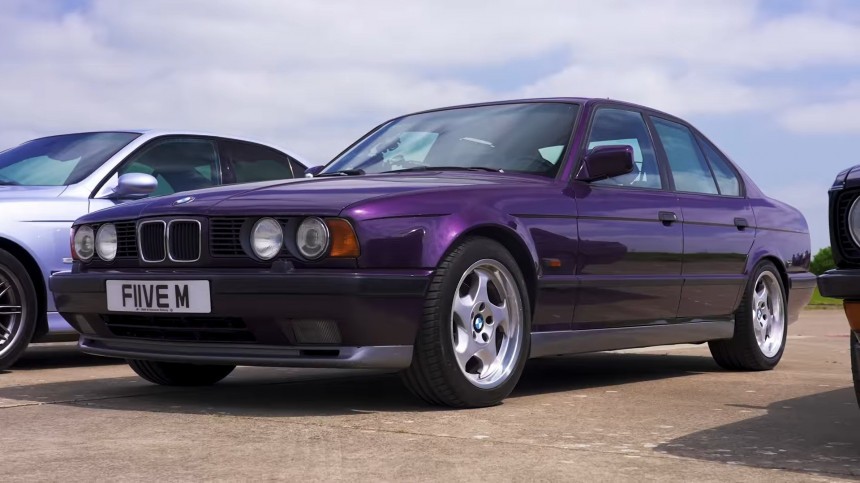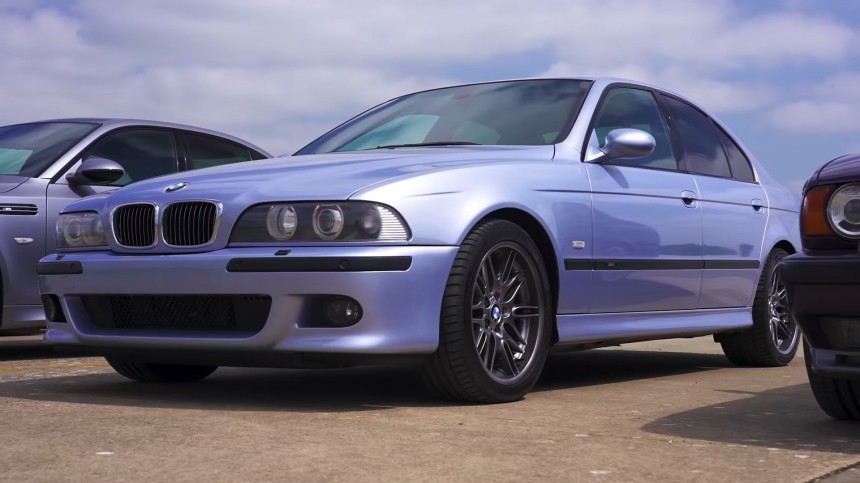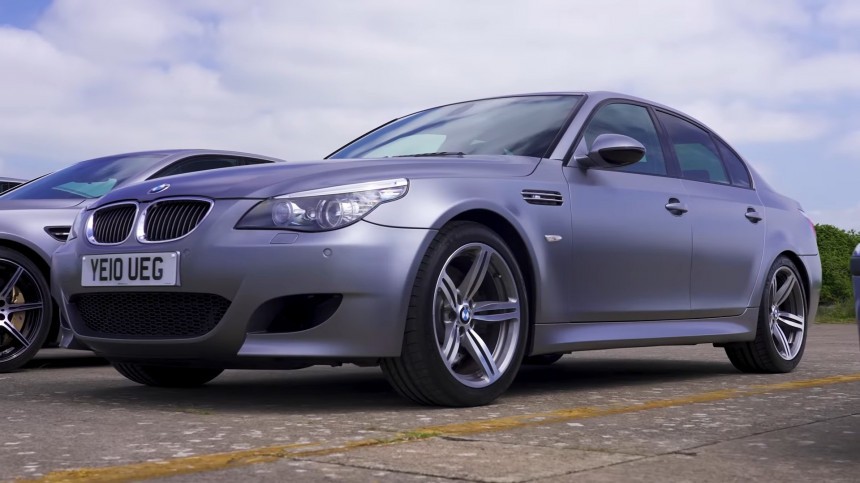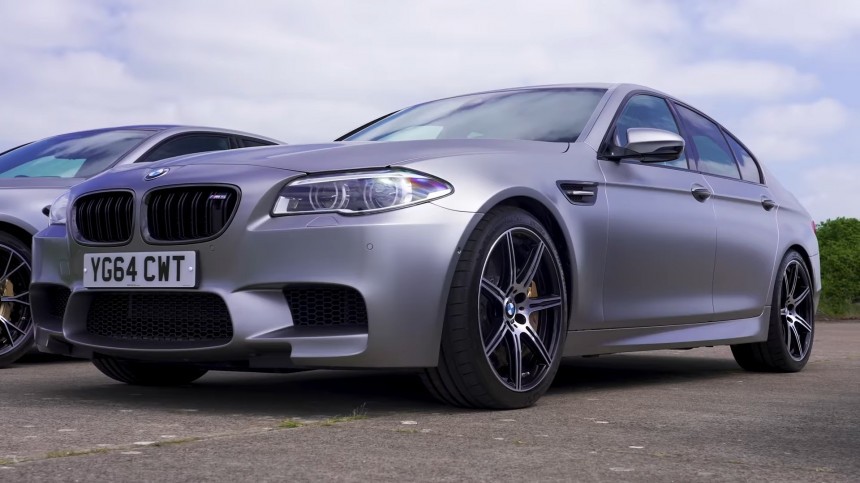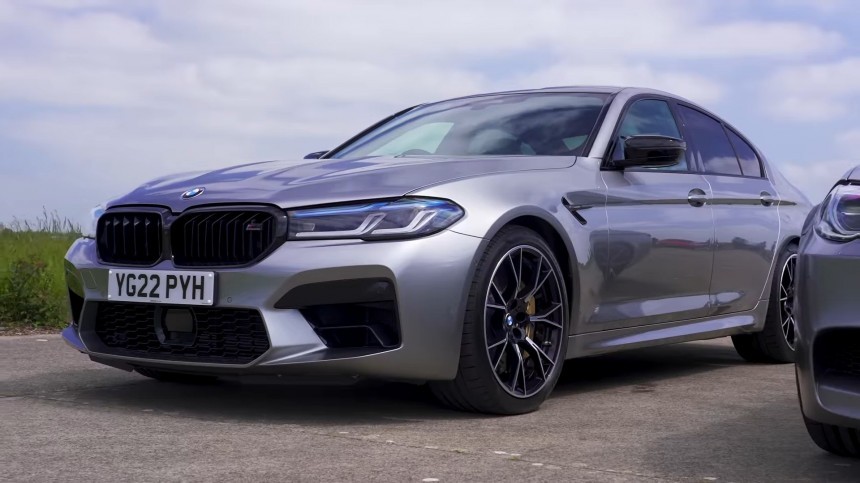Thirty-eight years ago, the Germans opened a Pandora’s box so unsatiable it continues to consume generations of cars to this day, and there is no stopping it. In 1985, the first of BMW’s M5 machines was introduced to the world. M was chosen as the most powerful letter of the alphabet, but when six M5s gather on a single drag strip, which rules supreme?
That’s why secondary letters tell each M5 apart, but literature is as good as a broken driveshaft at 440-yard conventions. So, Mat Watson from carwow arranged a customary family reunion for Munchen’s flagships of the last four decades.
Naturally, this means racing from a standstill to the end of the quarter mile; the winner stays on the track and takes on the next-generation model. This implies a chronological showdown between BMW’s finest.
Apart from the time-ignoring competition itself, this race serves a higher purpose. Since all cars involved are of the same family, the multiple rounds are a good metric for automotive progress over forty years of performance-chasing development.
It wouldn’t make a good impression on BMW fanboys if we didn’t call their apostles of the Demon of Speed by their war cry call sings. Without further ado, here are the stars of this epic fratricide: E28, E34, E39, E60, F10, F90. While these ciphers bear volumes of sacred knowledge for avid gearheads, they might confuse an innocent bystander.
The E28 was BMW’s first take on the “performance drivetrain in a street car” initiative rooted in the M1 supercar project of the 80s. This scheme ultimately failed in itself but gave the Germans a great idea. Instead of building a red-hot speed machine from the ground up, why not make the most practical decision of them all and use what’s already available?
In 1985, that availability checkbox was ticked by the BMW 5-Series, a 3.5-liter race engine with six inline cylinders and a five-speed manual gearbox. On the outside, only subtle details revealed it as an athlete in a two-button suit. The powertrain, however, made it the world's fastest regular production four-door sedan.
The naturally-aspirated straight-six was at the top of the food chain in its heyday, with 286 PS and 340 Nm (282 hp and 251 lb-ft) – all for the rear wheels. Thirty-eight years ago, that was a lot, especially in a car that weighed 3,185 lbs (1.45 tons).
Only three short years after its introduction, the M5 received its first generational renewal. In 1988, the E34 variant was released, and it was a significant step up from the inceptor model. The new speed-chasing road-legal BMW sedan gained little in displacement (3.8 liters vs. 3.5 in 1985), but the power increase was respectable.
The same naturally-aspirated inline-six architecture delivered 340 PS and 400 Nm (335 hp / 295 lb-ft). Again, all reserved for the rear wheels, courtesy of a five-speed manual gearbox. The bigger engine was offered from 1991 onward; up to that moment, the second generation of M5 had the same displacement but with higher ratings (315 PS / 311 hp and 360 Nm / 266 lb-ft).
The most dramatic modification, however, was the weight: in three years, the new M5 gained nearly 500 lbs (220 kg), tipping the scales at 3,682 lbs (1,670 kg). Naturally, the power-to-weight ratio works against the younger (or less old?) M5.
But this is where math and pistons collide, and the latter win (they’re made of metal, unlike arithmetic, which is made of formulas). The E34 leaves its forerunner behind so badly that one might think the venerable E28 fried a piston. That’s how much of a giant leap BMW took in just three years. In clicks-per-quarter-mile, that’s a 1.4-second gap at the end of the line. The E34 finishes In 14.6 seconds, and the E28 in 16 flat.
Next up on the track is the famous E39. This model starred in the most spectacular car commercial of all time – play the second video for a bit of late 90s German humor. The third descendant of the M5 clan brought a scary weapon to the fight: a 5.0-liter free-breathing V8 that dropped 400 PS and 500 Nm (394 hp and 369 Nm). A six-speed manual transmission puts the power down via the rear wheels.
This wasn’t a gallant athlete in an elegant suit anymore but a full-blown muscle-bound car with road manners. For comparison, its 0-62 mph / 100 kph time was a second under the E34: 5.3 vs. 6.3. The E39 is marginally heavier – less than 50 lbs – than its older brother.
Again, the technological advancement achieved between these two M5s is evident and self-explanatory: the E39 drops the E34 by a landslide. In this second race, the winner killed the stopwatch after 14.5 seconds, while its opponent managed a disappointingly low 15.6 run (a full second slower than in the previous round against the E28).
Like every single carmaker on Planet Piston, BMW M5s gained more power as the generational gap increased. The fourth iteration of the famous Motorsport division from Munchen, the E60, came with a five-liter displacement, but equally divided between ten cylinders.
Also naturally aspirated, this engine offered 507 PS and 520 Nm (500 hp, 384 lb-ft). It also had to drag around a bulk of 4,035 lbs (1,830 kg). As the years passed and performance numbers grew, so did the gears in the transmission. The E60 sent its firepower to the rear wheels via a seven-speed automatic gearbox with launch control.
Naturally, the E60 takes no prisoners, not sparing even its own blood, and mauls the E39 big time. 12.7 seconds for the ugliest M5 in history, while the best-looking E39 bests a 14.8 time. Time to change letters…
The fifth-gen M5 gained the F10 internal code but lost cylinders and engine size – a premiere for the M5 family. The engineers fitted it with two dual-scroll turbos to compensate for this downgrade. Correspondingly, the 4.4-liter V8 rapid-fires 560 PS and 678 Nm (553 hp / 500 lb-ft). The transmission was upgraded to a dual-clutch seven-speed auto, but the M5 staple move of RWD was left untouched.
By the time the F10 M5 hit the streets, the motoring evolution had slowed down its pace, and transgenerational differences weren’t as striking as in the early days. Weight differences begin to shrink from generation to generation, and at 4,122 lbs (1,870 kg), the F10 is only 90 lbs fatter than the E60.
Still, the F10 scores a win against the E60, with a best 1,320-foot sprint time of 12.6 seconds. Unfortunately, the F10 drops its balls during a second run and forfeits. Take that literally: the driveshaft gives up and spreads 1-inch steel spheres on the track. That effectively wipes out the generation-five BMW M5, leaving the dated E60 to battle against the F90 M5 Competition supercar.
Powered by an upgraded 4.4-liter twin-turbo V8 with 625 PS and 750 Nm / 617 hp, 553 Nm), the latest M5 in the 38-year-old six-model lineup is the most powerful of the bunch. The best possible comparator tool available is the crude 0-62 mph (100 kph) score. The newest BMW M5 is twice as fast as the dynasty’s founder: 3.3 seconds in 2023 vs. 6.5 seconds in 1985.
And it also has – for the first time in an M5 – all-wheel drive (which can be deactivated to render the current flagship into an RWD-only bimmer). But the mechanical impeachment does little to nullify the car’s cutthroat demeanor: the F90 crosses the line in 11.8 seconds. To do full justice to the raging sedan, the AWD quarter-mile time is 11.2 seconds, 33% faster than its 1985 counterpart.
Naturally, this means racing from a standstill to the end of the quarter mile; the winner stays on the track and takes on the next-generation model. This implies a chronological showdown between BMW’s finest.
Apart from the time-ignoring competition itself, this race serves a higher purpose. Since all cars involved are of the same family, the multiple rounds are a good metric for automotive progress over forty years of performance-chasing development.
The E28 was BMW’s first take on the “performance drivetrain in a street car” initiative rooted in the M1 supercar project of the 80s. This scheme ultimately failed in itself but gave the Germans a great idea. Instead of building a red-hot speed machine from the ground up, why not make the most practical decision of them all and use what’s already available?
In 1985, that availability checkbox was ticked by the BMW 5-Series, a 3.5-liter race engine with six inline cylinders and a five-speed manual gearbox. On the outside, only subtle details revealed it as an athlete in a two-button suit. The powertrain, however, made it the world's fastest regular production four-door sedan.
Only three short years after its introduction, the M5 received its first generational renewal. In 1988, the E34 variant was released, and it was a significant step up from the inceptor model. The new speed-chasing road-legal BMW sedan gained little in displacement (3.8 liters vs. 3.5 in 1985), but the power increase was respectable.
The same naturally-aspirated inline-six architecture delivered 340 PS and 400 Nm (335 hp / 295 lb-ft). Again, all reserved for the rear wheels, courtesy of a five-speed manual gearbox. The bigger engine was offered from 1991 onward; up to that moment, the second generation of M5 had the same displacement but with higher ratings (315 PS / 311 hp and 360 Nm / 266 lb-ft).
But this is where math and pistons collide, and the latter win (they’re made of metal, unlike arithmetic, which is made of formulas). The E34 leaves its forerunner behind so badly that one might think the venerable E28 fried a piston. That’s how much of a giant leap BMW took in just three years. In clicks-per-quarter-mile, that’s a 1.4-second gap at the end of the line. The E34 finishes In 14.6 seconds, and the E28 in 16 flat.
Next up on the track is the famous E39. This model starred in the most spectacular car commercial of all time – play the second video for a bit of late 90s German humor. The third descendant of the M5 clan brought a scary weapon to the fight: a 5.0-liter free-breathing V8 that dropped 400 PS and 500 Nm (394 hp and 369 Nm). A six-speed manual transmission puts the power down via the rear wheels.
Again, the technological advancement achieved between these two M5s is evident and self-explanatory: the E39 drops the E34 by a landslide. In this second race, the winner killed the stopwatch after 14.5 seconds, while its opponent managed a disappointingly low 15.6 run (a full second slower than in the previous round against the E28).
Like every single carmaker on Planet Piston, BMW M5s gained more power as the generational gap increased. The fourth iteration of the famous Motorsport division from Munchen, the E60, came with a five-liter displacement, but equally divided between ten cylinders.
Naturally, the E60 takes no prisoners, not sparing even its own blood, and mauls the E39 big time. 12.7 seconds for the ugliest M5 in history, while the best-looking E39 bests a 14.8 time. Time to change letters…
The fifth-gen M5 gained the F10 internal code but lost cylinders and engine size – a premiere for the M5 family. The engineers fitted it with two dual-scroll turbos to compensate for this downgrade. Correspondingly, the 4.4-liter V8 rapid-fires 560 PS and 678 Nm (553 hp / 500 lb-ft). The transmission was upgraded to a dual-clutch seven-speed auto, but the M5 staple move of RWD was left untouched.
Still, the F10 scores a win against the E60, with a best 1,320-foot sprint time of 12.6 seconds. Unfortunately, the F10 drops its balls during a second run and forfeits. Take that literally: the driveshaft gives up and spreads 1-inch steel spheres on the track. That effectively wipes out the generation-five BMW M5, leaving the dated E60 to battle against the F90 M5 Competition supercar.
Powered by an upgraded 4.4-liter twin-turbo V8 with 625 PS and 750 Nm / 617 hp, 553 Nm), the latest M5 in the 38-year-old six-model lineup is the most powerful of the bunch. The best possible comparator tool available is the crude 0-62 mph (100 kph) score. The newest BMW M5 is twice as fast as the dynasty’s founder: 3.3 seconds in 2023 vs. 6.5 seconds in 1985.
